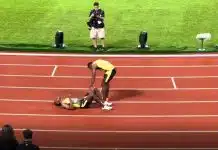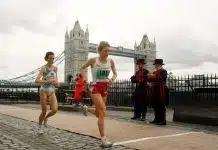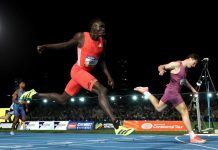It takes a (comparatively) long time for a discus thrown from one side of a field to fly through the air and come down some 75 metres distance from whence it was launched. It takes no time at all to spark a discussion.
A year ago, Mykolas Alekna went to Millican Field at self-styled ‘Throw Town’ more prosaically known as Ramona, Oklahoma (pop. 535 at the 2010 US census), and threw 74.35 metres, breaking a world record set by Jurgen Schult of the former German Democratic Republic back in 1986, the oldest men’s world mark. Twenty-one years old, son of two-time Olympic champion Virgilijus Alekna, Mykolas was born to throw far. But that far?
“Oklahoma! Where the winds come sweeping down the plain,” as the song from the musical of the same name goes. And when those sweeping winds blow in the right direction, you can throw the discus a long, long way indeed. Some expressed misgivings at what they saw as a flagrant exploitation of freakish conditions. The term “weather doping” – seeking out favourable conditions to enhance performance – was heard, but the world sat up and took note.

One of the note-takers was Matt Denny, whose gradual climb through the ranks of the world’s throwers last year brought an Olympic bronze medal in Paris and a second successive victory in the Diamond League final in Brussels. He wanted to see what he could do utilising the conditions on offer in Ramona. Denny skipped the national titles and headed to the US with his coach, Dale Stevenson. The Throws Series runs daily for almost a full month. Denny threw 72:07 in his first competition, before an oh-so-close to the world record 74.25 in his second.
The stage was set for a showdown with Alekna. This clash of titans did not disappoint, though it was settled quickly. Alekna struck first with a world record 74.89 in the first round, then improved to 75.56, another world record, on his fourth effort. Two valid throws out of six, both world records. Denny gradually pushed out from a mid-60s opener to three throws in the 70-72 range and then a massive/not quite massive enough 74.78 in the fifth round. He closed with a 73.36.
Denny’s best leaving Australia was 69.96. In three Throw Town meetings he had 15 of 18 throws over 70 metres, including two beyond 74 metres and three each at 73 and 72 metres. Ideal conditions or no, he pushed the world record holder to a new world record and is now the second-best performer all-time (he arrived in Ramona as number 33).
This display of awesome consistency kicked off an immediate discussion in one of the several groups your correspondent belongs to. One contributor wondered whether Denny was our most consistent thrower ever. Depends how you measure consistency, I guess. Matt has now been top-10-ranked five years in a row by Track&Field News, fourth and third in 2023 and 2024, and will almost certainly make it six in a row in 2025.
But we’ve had some outstanding female discus throwers, too. There’s Olympic silver medallist Daniela Costian and Lisa-Marie Vizaniari for a start, but it’s Dani Stevens who unquestionably stands with Matt Denny at the peak of Australian shades for longevity – though Matt’s not done yet – and matches his consistency. Stevens was the youngest-ever world champion when she won in Berlin in 2009. She got her first world top 10 ranking a year earlier, beginning a run of 11 straight years. In six of those 11 years, Stevens ranked in the top five and she added a world championships silver in 2017 and an Olympic fourth in 2016 to her world championships gold. That’s awesome consistency, too.

And if you want a couple more statistics showing how close Stevens and Denny are, Stevens is still ranked 32 all-time on the world list (Denny was 33 pre-Oklahoma) and her personal best is 69.64 metres (Denny 69.96 pre-Oklahoma). Pressed to choose, I’d still refuse.

I took an earlier look at this whole consistency thing in a column at the end of 2021. Posing the question as to who might be our best athlete, I argued that it depended how you looked at it.
“Some would say it has to be an Olympic or world champion, a world record breaker, or perhaps both. Others might look at longevity, consistent excellence over a period of years. Then there’s the impact of a single performance: Ralph Doubell’s world record-equalling win in the 800 metres in Mexico City, Herb Elliott’s smashing world record victory in the 1500 in Rome, Cathy Freeman withstanding the crushing build-up of pressure to win the 400 in Sydney.
“Not many would suggest Pam Ryan, but for excellence in a single event over an extended period, you could mount a case. Ryan’s signature event was the sprint hurdles, run over 80 metres until 1969 and thenceforth over 100. She was ranked in the world top-10 by Track & Field News no fewer than 11 times – 10 in succession from 1961 to 1970, and again in 1972.
“Ryan also ranks high against other criteria. Though never an Olympic gold medallist she was third in Tokyo in 1964, second in Mexico City in 1968 (both these over 80 metres) and fourth in Munich in 1972 (over 100 metres). World records? Ryan set two over 80 and one over 100 metres.
“In earning 11 world top-10 rankings, Ryan was never lower than fourth. She was ranked number one on three occasions, number two on four, number three once and number four three times. No other Australian comes close to those numbers over a similar period.
“With 95 points in the hurdles Ryan shares top billing all-time in the event with American sprinter/hurdler Gail Devers. She is the only Australian athlete to be number one scorer in a single event.”
Turning to some of our current competitors, high jump pair Nicola Olyslagers and Eleanor Patterson have 33 and 28 points, respectively, javelin stars Kelsey-Lee Barber and Mackenzie Little 35 and 25, Denny 23 and middle-distance star Jess Hull 13. All still going, but a way to go yet.















